If you’re planning a whale watching trip in Maui, you’re in for an unforgettable experience. But did you know, there’s more to whale watching than just spotting them? Knowing how to Identify whale species in Maui adds a whole new level of excitement and appreciation to your adventure.
With Maui being home to various types of whales, you could have plenty of opportunities to spot and identify some of them. This guide I have put together will help you distinguish between the fourteen whale species in Maui that are possible to see. With the help of this guide, you’ll know whether you’re looking at a humpback, a sei whale, or even a sperm whale.
Key Takeaways
- Identifying whales involves observing their size, blow patterns, dorsal fin shape, fluke patterns, and behavior.
- Utilize binoculars or spotting scopes, learn about whale migration patterns and behaviors, and observe seabird activity for clues about whale presence.
- Humpback whales are the most frequent sightings, but you might also encounter fin whales, minke whales, blue whales, sperm whales, and even the critically endangered North Pacific right whale, among others
- Maintain a safe distance, avoid harassing whales, and follow the guidance of experienced whale watching tour boat crews.
Understanding the Basics of Whale Identification
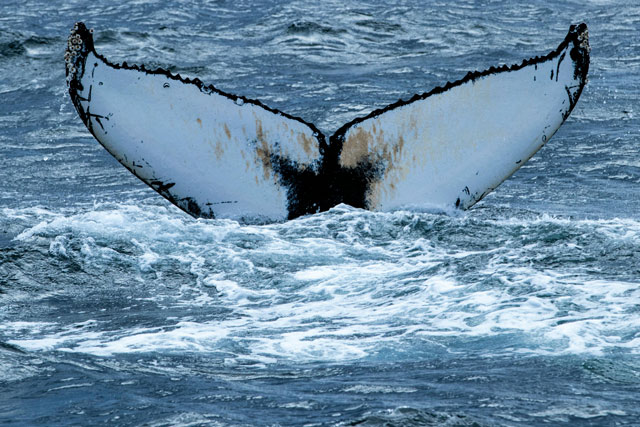
Identifying whale species in Maui isn’t as tricky as it sounds, especially once you know what to look for. Here are the main features to focus on:
- Size: Whales in Maui range in size from the relatively small false killer whale (up to 33 feet) to the gigantic blue whale (up to 100 feet).
- Blow: Each whale species in Maui has a unique blow pattern. Humpbacks have a bushy blow, while fin whales produce a tall, column-like spout.
- Dorsal Fin Shape: Pay attention to the shape, size, and location of the dorsal fin.
- Flukes and Tails: Humpback whales, for example, have distinctive tail flukes with unique patterns.
- Behavior: Some whale species in Maui are more likely to breach, while others prefer staying closer to the surface.
Tips for Spotting Whales
- Bring the Right Gear
A good pair of binoculars can make a world of difference when identifying whale species. Spotting scopes are another excellent tool for serious whale watchers. - Know the Migration Patterns
The whale species in Maui are mainly in the area from January through March. During this time, you’ll have the best chance of seeing multiple types of whales in a single outing. - Learn Whale Behavior Patterns
Each whale species in Maui exhibits unique behaviors that can help you identify them. For example, humpbacks are famous for breaching and slapping their fins, while fin whales are more likely to glide swiftly through the water without dramatic movements. Observing how a whale moves and interacts with its environment can provide valuable clues. - Watch the Birds
Though it’s rare to catch the larger whales feeding in the waters of Maui because they are relying on their fat reserves to get them by, seabirds can alert you to possible whale feeding taking place. Seabirds like gulls often flock around feeding whales, especially during feeding taking place around the water’s surface. If you notice a cluster of birds diving and circling, it’s a good indication that whales might be nearby.
Common Whale Species in Maui
Maui’s location as a destination point of the Pacific migratory route makes it a hotspot for a number of whale species. Here’s my list of the most common whale species in Maui you’re most likely to see:
Humpback Whale

Humpbacks are the stars among the whale species in Maui. Known for their acrobatic breaches and long pectoral fins, they’re relatively easy to spot and identify. Look for:
- A bushy blow about 10 feet high.
- Black and white patterns on their flukes.
- Long, white pectoral fins, often visible when they swim close to the surface.
- If you see a whale breaching (jumping out of the water), it’s most likely a humpback. They’re the most playful species out of the great whales (the larger whales with the minke whale being the smallest member) in Maui’s waters.
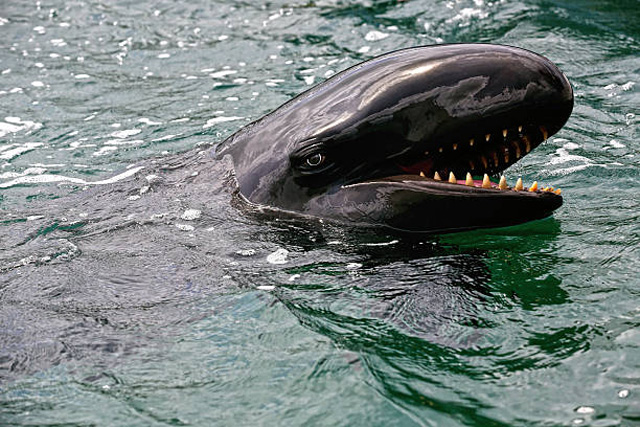
False Killer Whale
Despite their name, these animals are actually dolphins, not whales. They are highly social and are one of the whale species in Maui that often travel in large, stable groups.
- Size: medium-sized, reaching up to 23 feet in length.
- Blow: A single, low, bushy blow.
- Dorsal Fin: Tall, curved, and sickle-shaped.
- Body: Dark gray to black with a lighter gray underside.
- Behavior: Highly social, often seen in large pods. They are known to be active predators, hunting in groups and sometimes even preying on other marine mammals.
Short-finned Pilot Whale
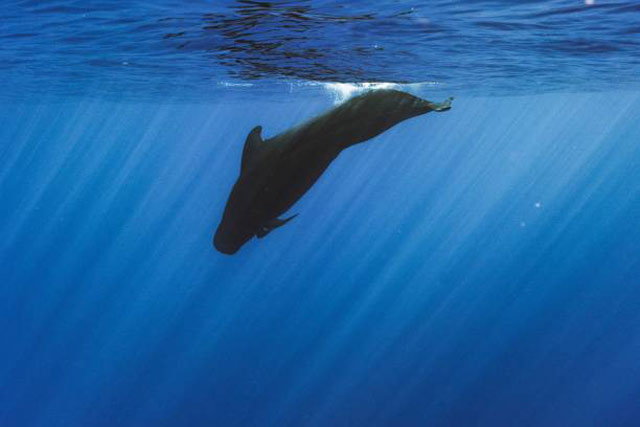
This highly social whale species in Maui is known to travel in large pods, sometimes numbering in the hundreds.
- Size: Medium-sized, reaching up to 20 feet in length.
- Blow: A single, low bushy blow.
- Dorsal Fin: Tall, curved, and sickle-shaped.
- Body: Dark gray to black with a lighter gray underside.
- Behavior: Highly social, often seen in large pods.
Less Common Whale Species in Maui
While humpback whales are the undisputed stars of the whale species in Maui, you might be lucky enough to spot one of these less common species. Though sightings are rare, they add an extra thrill for whale watchers.
Fin Whale
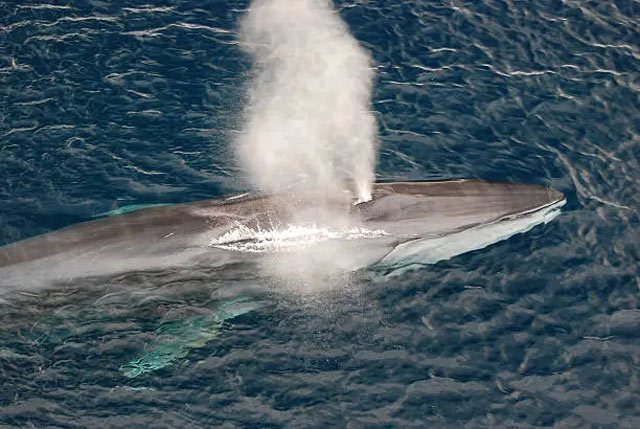
The second-largest animal on Earth, fin whales are sleek and fast swimmers. They often travel in small groups or pairs. Look for:
- A tall, column-shaped blow, up to 20 feet high.
- A sleek, grayish-brown body with a white underside.
- A small, curved dorsal fin set far back on their body.
Minke Whale
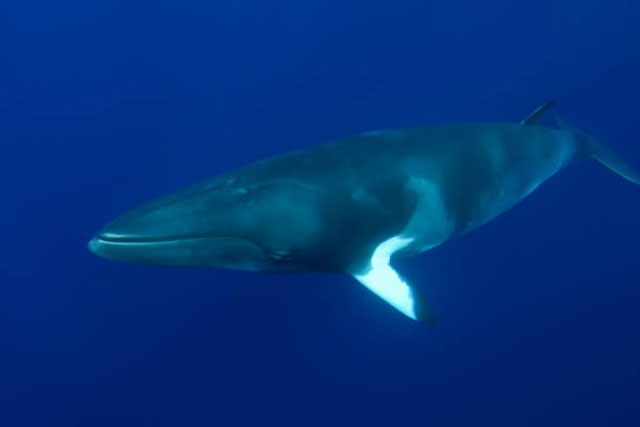
Minke whales are smaller and shyer than most of the other whale species in Maui, growing up to 35 feet in length. But, they’re still a treat to spot. Look for:
- A pointed snout and streamlined body.
- A small, hooked dorsal fin located about two-thirds down their back.
- Unique white bands on their pectoral fins.
Fun Fact!
Minke whales are sometimes nicknamed “stinky minkes” because of the strong odor they emit from their blowholes!
Blue Whale
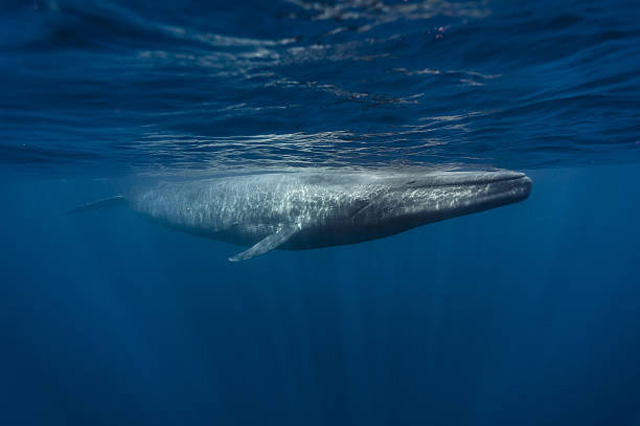
The largest animal on Earth, blue whales are a breathtaking sight. These gentle giants can reach up to 100 feet in length and weigh as much as 200 tons. Look for:
- A tall, narrow blow reaching up to 30 feet in the air.
- A mottled blue-gray body, often described as looking like marble.
- A relatively small dorsal fin positioned far back on their body.
- Fun Fact #1 (new): Blue whales have hearts the size of a small car and can pump over 60 gallons of blood with each beat!
Sei Whale
The third-largest baleen whale after the blue whale, the Sei whale is a streamlined and fast swimmer.
- Size: Large, reaching up to 65 feet in length.
- Blow: A tall, narrow blow, up to 30 feet in the air.
- Dorsal Fin: Sickle-shaped and located far back on the body.
- Body: Slender and dark gray with irregular white markings on the underside.
- Behavior: Known for their speed and agility, often seen traveling in small groups.
Bryde’s Whale
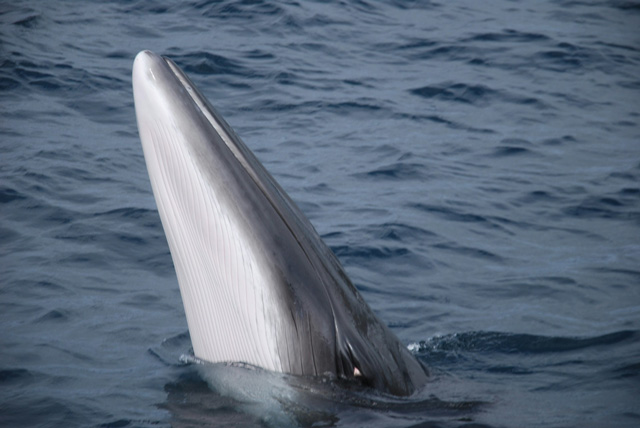
Often mistaken for sei whales, Bryde’s whales have three prominent ridges on their heads, a unique identifying feature among the whale species in Maui.
- Size: Medium-sized, reaching up to 55 feet in length.
- Blow: Two bushy blows, often merging into one.
- Dorsal Fin: Relatively small and hooked.
- Body: Grayish-brown with three prominent ridges on the head.
- Behavior: Often seen traveling in small groups or alone, known to feed by skimming the surface of the water.
Gray Whale
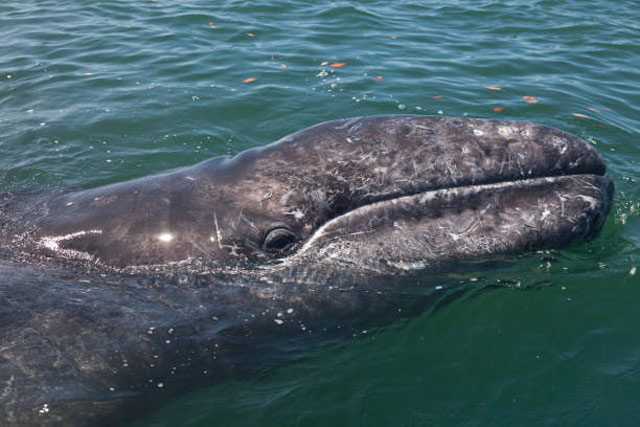
These whales are known for their annual migrations, one of the longest migrations of any mammal.
- Size: Medium-sized, reaching up to 49 feet in length.
- Blow: Two short, bushy blows.
- Dorsal Fin: Small and triangular.
- Body: Grayish-black with white patches on the belly and chin.
- Behavior: Known for their distinctive feeding behavior, where they use their heads to disturb the seafloor and then suck up sediment and prey.
Cuvier’s Beaked Whale
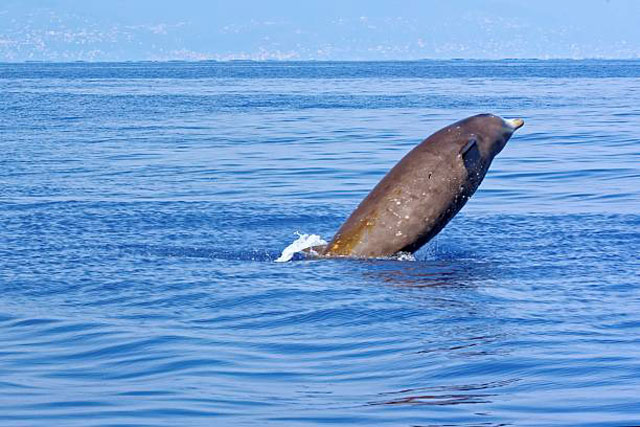
One of the deepest-diving whales, Cuvier’s beaked whales have been recorded diving to depths exceeding 9,800 feet.
- Size: Medium-sized, reaching up to 13 feet in length.
- Blow: A single, low, inconspicuous blow.
- Dorsal Fin: Small and sickle-shaped.
- Body: Dark gray to black with lighter gray markings on the flanks.
- Behavior: Deep divers, known for their extreme diving depths.
Blainville’s Whale
These highly social whales often travel in large groups, sometimes numbering in the thousands.
- Size: Medium-sized, reaching up to 11 feet in length.
- Blow: A single, low, inconspicuous blow.
- Dorsal Fin: Small and sickle-shaped.
- Body: Dark gray to black with lighter gray markings on the flanks.
- Behavior: Deep divers, often seen in small groups.
Pygmy Sperm Whale
The second smallest of the sperm whales, these deep-diving creatures are ra whale species in Maui that’s arely seen at the surface.
- Size: Small, reaching up to 13 feet in length.
- Blow: A single, low, inconspicuous blow.
- Dorsal Fin: Small and triangular.
- Body: Dark gray to black with a lighter gray underside.
- Behavior: Deep divers, often found in deep offshore waters.
Sperm Whale
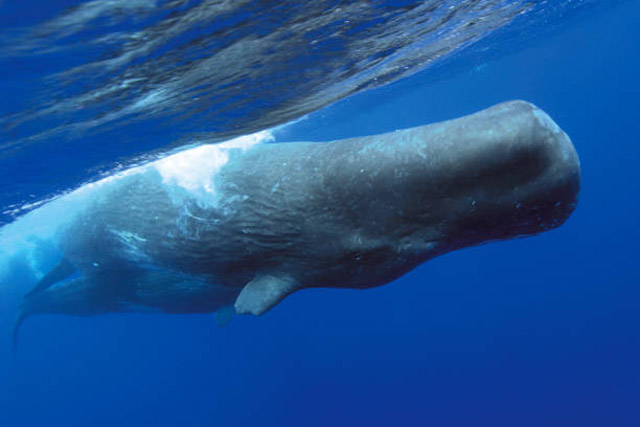
Known for their distinctive square-shaped heads, sperm whales are deep divers often found in deeper offshore waters. They’re certainly a whale species in Maui that’s less likely to be seen, but occasionally, they’ll surprise you. Look for:
- A single, angled blow spouting forward.
- A blocky head that makes up nearly one-third of their body length.
- Wrinkled, gray skin, often compared to prunes.
Pro Tip!
Pro Tip: Sperm whales can stay submerged for up to 90 minutes during deep dives, so if you spot one, be patient—it may resurface nearby.
North Pacific Right Whales
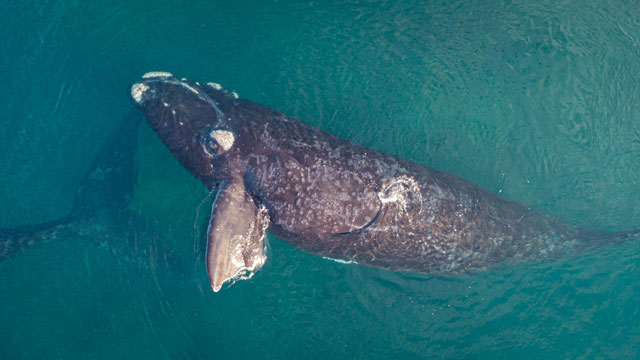
Critically endangered, North Pacific right whales are a rare and special sight in Maui waters. These whales are slow-moving and often stay near the surface, making them easier to spot when present. Look for:
- A V-shaped blow, created by their two blowholes.
- Callosities (raised, rough patches) on their heads, which are unique to each whale.
- A stocky, black body with no dorsal fin.
Not so Fun Fact 🙁
North Pacific right whales were named “right whales” because they were considered the “right” whales to hunt due to their slow swimming and tendency to float after being killed. Today, they’re fiercely protected.
Orca (Killer Whale)
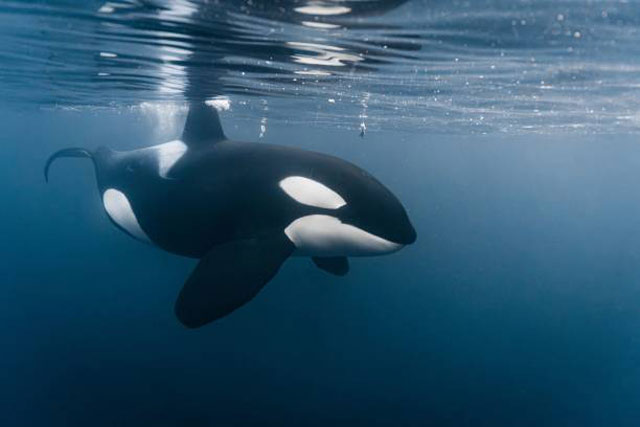
These highly intelligent and social animals are apex predators of the ocean.
- Size: Large dolphin, reaching up to 32 feet in length.
- Blow: A single, low, bushy blow.
- Dorsal Fin: Tall, curved, and falcate (sickle-shaped).
- Body: Black and white with distinctive markings, including a white eye patch and a white saddle patch behind the dorsal fin.
- Behavior: Highly social and intelligent, they live in complex social structures with distinct pods and dialects. They are apex predators, hunting in coordinated groups and preying on a wide variety of marine mammals, fish, and seabirds.
Pro Tip!
Pay attention to the direction whales are traveling. Migratory patterns can help you predict whether you’re spotting the same whale or a new one.
Why Identifying Whale Species in Maui Matters
Learning to identify different whale species in Maui enhances your connection to the ocean and its inhabitants. By recognizing the unique characteristics of each species, you gain a deeper appreciation for their diversity and the intricate role they play within the marine ecosystem. Observing humpback whales breaching, observing the distinctive flukes of a migrating gray whale, or spotting the playful acrobatics of dolphins creates a profound and unforgettable experience.
Furthermore, identifying whale species in Maui contributes significantly to conservation efforts. Citizen scientists play a vital role in gathering valuable data on whale populations and behaviors. By sharing your sightings with researchers through online platforms or local organizations, you become an active participant in marine research. This information helps scientists track migration patterns, monitor population health, and identify areas that require special protection. For example, documenting the presence of endangered species like the North Pacific right whale provides crucial information for conservationists working to protect these vulnerable populations.
And so, becoming familiar with the characteristics of different whale species in Maui, not only deepens your own understanding of the ocean but also contributes to the vital work of protecting them.
Whale Watching Etiquette
When observing whales, it’s essential to prioritize their safety and comfort:
- Keep a respectful distance of at least 100 yards.
- Never chase or harass whales.
- Follow the captain’s guidance on a whale watching tour.
Conclusion
Watching whale species in Maui is about more than spotting these majestic creatures—it’s about immersing yourself in their world. Whether you’re using this guide on a boat tour or from a cliffside perch, remember to soak in every moment and appreciate the incredible biodiversity Maui has to offer.


